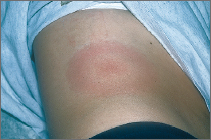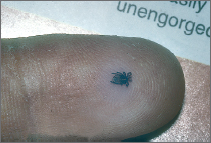It is a noncontagious illness caused by bacteria known as Borrelia burgdorferi.
It's spread by the bite of an infected tick, Ixodes scapularis, commonly known as the deer tick. However, not all deer ticks are infected with the bacteria that cause the disease.
Lyme disease rash
In its nymphal (immature) stage, the tick is about the size of a poppy seed or the period at the end of this sentence.
What are the symptoms of the disease?
Early symptoms include an expanding, red, ringlike rash that may appear around the area of the tick bite.
Other early symptoms may include flulike symptoms, such as tiredness, headache, fever, and achy muscles and joints.
Late symptoms may include arthritis, neurologic problems, and heart problems.
Lyme disease, tick
Early symptoms of Lyme disease usually occur within the first month of the tick bite.
Late symptoms can occur several weeks to several months later.
Lyme disease may be difficult to diagnose because the symptoms can mimic many other disorders.
Blood tests can be helpful in the diagnosis of Lyme disease but should not be used exclusively. Doctors may perform blood tests to examine for antibodies of the bacteria.
Lyme antibodies can be absent early in the course of a Lyme disease infection, so a negative test result may be misleading.
It is easily treated when detected in the early stages. Treatment with oral antibiotics, such as doxycycline or amoxicillin, for a few weeks are often effective.
Intravenous antibiotic treatment may be necessary for patients with late symptoms of Lyme disease.
Sometimes treatment is ineffective in the late stages, which underscores the importance of early diagnosis and treatment.

